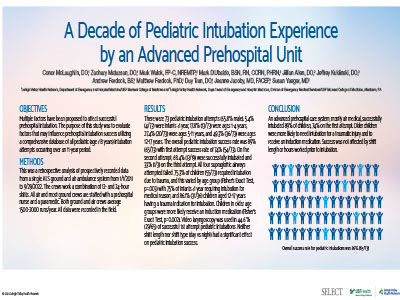ABSTRACTS
A Decade of 18. A Decade of Pediatric Intubation Experience by an Advanced Prehospital UnitAuthor: Jeanne Jacoby, Conor McLaughlin, Zachary Matuzsan, Mark Walck, Mark DiUbaldo, Jeffrey Kuklinski, Andrew Ferdock, Matthew Ferdock, Duy Tran, and Susan Yeager | | Associate Authors:
Introduction: Multiple factors have been proposed to affect successful prehospital intubation. Objective: To evaluate factors that may influence prehospital intubation success utilizing a comprehensive database of all pediatric (age < 18 years) intubation attempts occurring over an 11-year period. Methods: A retrospective analysis of prospectively recorded data from a single ALS ground and air ambulance system from January 1, 2011, to September 29, 2022, was performed. The crews worked a combination of 12- and 24-hour shifts. All air and most ground crews were staffed with a prehospital nurse and a paramedic. Ground and air crews each averaged 1500 to 2000 runs per year. All data were recorded in the field. Results: A total of 73 pediatric intubation attempts were made. Of these, 65.8% were male; 5.4% (4/73) were infants < 1 year, 17.8 % (13/73) were 1–4 years, 27.4% (20/73) were 5–11 years, and 49.3% (36/73) were 12–17 years. The overall pediatric intubation success rate was 89% (65/73), with a first-attempt success rate of 74% (54/73). On the second attempt, 68.4% (13/19) were successful; 33% (1/3) were successful on the third attempt. All four supraglottic airways attempted failed. A total of 55 (75.3%) of children required intubation due to trauma, and this varied by age group (Fisher's exact test, p = .003), with 75% of infants < 1 year requiring intubation for medical reason and 86.1% (31/36) children aged 12–17 years having a trauma indication for intubation. Children in older age groups were more likely receive an induction medication (Fisher's exact test, p = .002). Video laryngoscopy was used in 44.6% (29/65) of successful first-attempt pediatric intubations. Neither shift length nor shift type (day vs. night) had a significant effect on pediatric intubation success. Conclusion: An advanced prehospital care system, mostly air medical, successfully intubated 89% of children, 74% on the first attempt. Older children were more likely to need intubation for a traumatic injury and to receive an induction medication. Success was not affected by shift length or hours worked prior to intubation.
|

